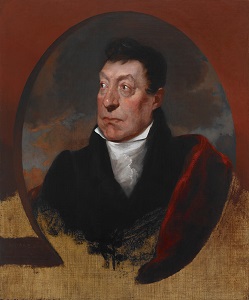We’re entering the last days in which guests may view the temporary exhibition American Encounters: Anglo-American Portraiture in an Era of Revolution, on view here at Crystal Bridges through September 15. Don’t miss this lovely assemblage of portraits from the collections of Crystal Bridges and our partner institutions: the Musée du Louvre in Paris, the High Museum of Art, Atlanta, GA; and the Terra Foundation for American Art, Chicago. In this second post of a two-part blog series, Curator Manuela Well-Off-Man discusses the works from Crystal Bridges’ collection that are being shown alongside the works from the traveling exhibition. To read part one, click here. –LD At Crystal Bridges, the American Encounters portrait exhibition is accompanied by four works from the Museum’s permanent collection that offer deeper insight into the role of portraiture in America during that time period, and how the sitters and artists were affected by, or even involved in, the historic events of the Revolutionary War.
Copley’s Daniel Rogers (1767) is a private portrait of a prominent businessman from Gloucester, MA who sought to establish his identity in the colonies through this portrait. As a colonial merchant, Daniel Rogers was subject to the aggressive British tax increases and trade laws. The artist, John Copley, associated with the Sons of Liberty and patriots such as John Hancock, Paul Revere, and Samuel Adams, but then decided to move to London in advance of the developing Revolution. His father-in-law Richard Clarke, on the other hand, was a loyalist and wealthy agent of the East India Company (whose tea was thrown in the Boston Harbor during the Boston Tea Party). Copley’s relationship to his wife’s family brought him close to the violent events of the Revolution.
Samuel Morse’s expressive study of Washington’s friend and ally, the Marquis de Lafayette (1826) commemorates the 50-year anniversary of the American Revolution. Lafayette was a French general and political leader who fought alongside Washington. (Read more about Lafayette and Morse here.) His troops were instrumental in winning the War of Independence and contributed to the victory at the battle of Yorktown in 1781. The portrait served as study for Morse’s full-length portrait at the New York City Hall.
The two other works are preliminary portrait studies for major works of American art that capture key moments in the history of the American Revolutionary War, such as Thomas Sully’s drawing for his epic painting Passage of the Delaware (1819, Museum of Fine Arts, Boston), and an intimate sketch of George Washington’s head rendered by Emanuel Leutze for his iconic work Washington Crossing the Delaware (1851, Metropolitan Museum of Art).
The paintings in the American Encounters exhibition demonstrate the complexity of levels artists, patrons, sitters were entangled in the historic events, or impacted by the war and its aftermath. The relationships between these works reveal that Britain and America were not only connected through politics, military conflicts and trade, but also through the arts.






